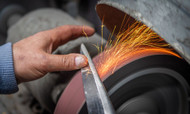Everything You Should Know About Knife Blade Grinds
Nov 9 2023 - 12:09
A knife blade grind plays an essential role in determining a cutting tool’s performance and functionality while improving its sharpness and strength. The process of grinding a blade helps you sharpen it to achieve the desired edge and angle, ultimately defining how well it cuts, holds an edge, and withstands use.
We’ll explain the primary purpose of blade grinds and what you should know about this useful tool to help you gain a thorough understanding of this crucial aspect of knife care.
The Purpose of Knife Blade Grinds
Before grinding your blade, you need to determine why you’re doing it. The two main reasons for knife blade grinding are to create an edge or sharpen a dull edge.
Grinding removes material from the blade, producing an edge capable of cutting through various materials. This task is common for knifemakers, but you might need to do this with a knife you own.
With regular use over time, a knife edge may lose its sharpness. Grinding restores the edge’s cutting efficiency by removing the dulled sections and revealing a sharp edge.
Factors for the Perfect Blade Grind
You should consider a few factors to get the ideal blade sharpness. First, pay attention to the grind angle. A lower angle (shallow grind) results in a sharper edge and better cutting capabilities, but it can make the blade more fragile. A higher angle (steep grind) yields a more durable edge but may compromise sharpness. Striking a balance between the two is the key to achieving the perfect edge.
Next, consider the material type and thickness. These two components strongly influence your choice of grind. A wide, thick blade may need a steeper grind to maintain durability, while a thin blade can benefit from a shallow grind, providing a sharper edge for easily slicing through materials.
The Different Types of Knife Blade Grinds
The most important thing to know about knife blade grinds is that each type has advantages and drawbacks. Here is a quick overview of some popular grinds:
Flat Grind
This type of grind features a continuous, even taper from the blade’s spine to the edge. It delivers a balance of sharpness and durability and is suitable for general purposes.
Hollow Grind
A hollow grind produces a concave surface, providing a very sharp edge at the cost of reduced strength. It is ideal for blades that require precise cutting and slicing abilities.
Convex Grind
Being the opposite of hollow grind, convex grind offers increased strength and durability due to its bulging curvature. This grind type is well-suited for blades handling heavy-duty tasks, like chopping, without compromising edge efficiency.
Regardless of the blade grind you choose, you need a quality knife that withstands its uses. Fortunately, we have many LT Wright Knives in stock at The Knife Connection that are great for people looking to shape a knife that fits their needs.
